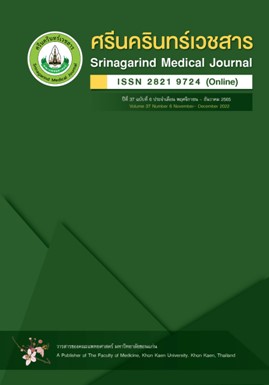ความสัมพันธ์ของมุมคอยื่นและความสามารถในการทรงท่าในผู้ที่มีคอยื่นไปด้านหน้า
Correlation between Craniovertebral Angle and Balance Ability in Forward Head Posture
Abstract
หลักการและวัตุประสงค์: คอยื่นไปด้านหน้า ทำให้กระดูกสันหลังระดับคอส่วนบนเหยียดและกระดูกสันหลังคอส่วนล่างงอ ทำให้เกิดการเสียสมดุลของร่างกาย ทำให้ปวดคอ กล้ามเนื้อเหยียดคอหดสั้น และกล้ามเนื้อก้มคอมัดลึกอ่อนแรง การศึกษานี้มีวัตถุประสงค์เพื่อศึกษาความสัมพันธ์ระหว่างมุมคอยื่นไปด้านหน้า (craniovertebral angle; CVA) และความสามารถในการทรงท่า โดยการทดสอบ functional reach test (FRT) ในอาสาสมัครสุขภาพดีที่มีคอยื่นไปด้านหน้า
วิธีการศึกษา: ศึกษาความสัมพันธ์ของ CVA ในผู้ที่มีคอยื่นไปด้านหน้ากับความสามารถในการทรงท่าโดยใช้การทดสอบ FRT ในอาสาสมัครที่มีมุมคอยื่นไปด้านหน้าจำนวน 26 ราย
ผลการศึกษา: พบว่าค่าความสัมพันธ์ระหว่าง CVA และ FRT มีค่า correlation coefficient คือ 0.23 ซึ่งไม่มีความสัมพันธ์กันอย่างมีนัยสำคัญทางสถิติ (p =.25)
สรุป: ความสัมพันธ์ระหว่างค่า CVA และ FRT อยู่ในระดับต่ำซึ่งไม่มีความสัมพันธ์ระหว่างมุมคอยื่นไปด้านหน้าและความสามารถในการทรงท่าโดยการทดสอบ FRT ในอาสาสมัครสุขภาพดีที่มีคอยื่นไปด้านหน้า
คำสำคัญ: มุมคอยื่น, ความสามารถในการทรงท่า, ผู้ที่มีคอยื่นไปด้านหน้า
Abstract
Background and objective: As a result of a poor forward head posture, the upper cervical spine is stretched and the lower cervical spine is bent, causing a loss of balance to the body, neck pain, shortening of the neck muscles and deep neck muscle weakness. The objective of this study was to observe the relationship between the forward angle of the neck (craniovertebral angle; CVA) and balance through the functional reach test (FRT) in healthy subjects with a forward head posture.
Methods: The relationship between CVA and FRT test was examined in 26 volunteers.
Results: The correlation between CVA and FRT demonstrated a correlation coefficient of 0.23, which presented no statistically significant correlation (p = 0.25).
Conclusion: The correlation between CVA and FRT was low, with no correlation between protruding neck angle and posture ability as observed via the FRT test in healthy individuals.
Keywords: craniovertebral angle, balance ability, forward head posture


